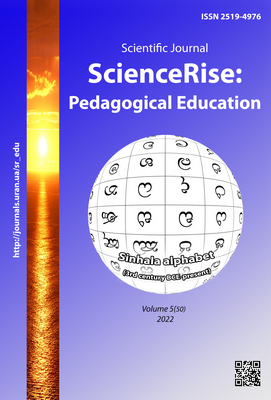Advantages and disadvantages of distance education in teaching clinical discipline to students of the medical university
DOI:
https://doi.org/10.15587/2519-4984.2022.264792Keywords:
distance learning, medical education, educational process, propaedeutics of pediatrics, questionnaires, studentsAbstract
The challenges of society have made adjustments to the medical education system of Ukraine. In the conditions of the pandemic of the coronavirus infection COVID-19 and the introduced martial law throughout the territory of Ukraine, distance learning (DL) turned out to be the only possible form of the educational process. The purpose of the study was to study the peculiarities of teaching the discipline "Propaedeutics of Pediatrics" in the conditions of the National Academy of Sciences. The process of DL at the Department of Propaedeutics of Childhood Diseases of the Dnipro State Medical University (DSMU) took place using the MOODLE electronic portal, the Google Meet video service, the YouTube platform, the website and the electronic magazine of the Dnipro State Medical University. An anonymous survey of 210 third-year students was conducted regarding their attitude and degree of satisfaction with the educational process at the Department of Propaedeutics of Childhood Diseases using educational distance technologies. As the results showed, the majority of the interviewed students are completely satisfied with the process of DL. However, when choosing a form of education, preference is still given to the classroom format of education. Among the advantages of DL, students noted the saving of time and financial costs for moving between buildings and clinical bases, the comfort of studying in a home environment, the possibility of studying at any convenient time, the availability of information resources, and the possibility of re-processing complex material. However, the biggest drawback of the DL was the lack of opportunity to work with the patient and master practical skills. So, DL, like any other method of teaching and learning, has its advantages and disadvantages. But currently existing technologies of medical education with the help of modern digital platforms, high-quality content filling of educational web resources, introduction of an effective system of quality control of acquired knowledge make it possible to adapt to the new realities of the educational process and ensure consistently high quality of medical education
References
- Pashkova, Yu. P., Palahniuk, H. O., Matokhniuk, M. O. (2021). Dosvid vprovadzhennia informatsiinykh tekhnolohii v protsesi vyvchennia klinichnoi dystsypliny u vyshchomu medychnomu navchalnomu zakladi. The Medical and Ecological Problems, 25 (1-2), 44–46. doi: http://doi.org/10.31718/mep.2021.25.1-2.11
- Herasymenko, O. І., Polesova, T. R., Gerasymenko, V. V., Kukhareva, N. S. (2022). Distance education in the professional training of future doctors: pro et contra. TRAUMA, 22 (5), 38–40. doi: https://doi.org/10.22141/1608-1706.5.22.2021.244466
- Skrypnyk, I. M., Maslova, G. S., Prykhodko, N. P., Gopko, O. F., Shaposhnyk, O. A. (2020). Using of distance education methods in medical education. PROBLEMS OF Uninterrupted Medical Training and Science, 39 (3), 29–32. doi: https://doi.org/10.31071/promedosvity2020.03.029
- Shevchuk, S. H., Khomaziuk, V. A., Ostashevska, T. H. (2020). Dystantsiine navchannia v medytsyni: dosvid vykladannia klinichnykh dystsyplin. Social function of science, teaching and learning, 276–278.
- Abaturov, O. Ye., Ahafonova, O. O. (2020). Experience of distance teaching of pediatrics to the fourth year students in medical higher education institutions of Ukraine in the conditions of the COVID-19 pandemic. Child`S Health, 15 (3), 200–203. doi: http://doi.org/10.22141/2224-0551.15.3.2020.204556
- Mishina, N., Ilchenko, S., Fialkovska, A. (2020). Discussion questions about the role of a lecture in the process of teaching the discipline “Propaedeutics of pediatrics” in the context of modern medical education. ScienceRise: Pedagogical Education, 3 (36), 52–57. doi: http://doi.org/10.15587/2519-4984.2020.203243
- Frolova, T. V., Senatorova, A. V., Tereshchenkova, I. I., Stenkova, N. F., Siniaieva, I. R., Atamanova, O. V. et. al. (2020). Dystantsiina forma navchannia yak skladova interaktyvnoi vzaiemodii studentiv i vykladachiv pry vykladanni propedevtyky pediatrii. Aktualni pytannia linhvistyky, profesiinoi linhvodydaktyky, psykholohii i pedahohiky vyshchoi shkoly. Poltava, 395–399.
- Ariaiev, M. L., Kaplina, L. Ye., Senkivska, L. I., Pavlova, V. V. (2020). The first experience of distance learning in medical universities of Ukraine under the conditions of COVID-19 quarantine. Child`S Health, 15 (3), 195–199. doi: http://doi.org/10.22141/2224-0551.15.3.2020.204555
- Hilburg, R., Patel, N., Ambruso, S., Biewald, M. A., Farouk, S. S. (2020). Medical Education During the Coronavirus Disease-2019 Pandemic: Learning From a Distance. Advances in Chronic Kidney Disease, 27 (5), 412–417. doi: http://doi.org/10.1053/j.ackd.2020.05.017
- Roller-Wirnsberger, R., Zitta, S., Herzog, C., Dornan, H., Lindner, S., Rehatschek, H. et. al. (2019). Massive open online courses (MOOCs) for long-distance education in geriatric medicine across Europe. European Geriatric Medicine, 10 (6), 989–994. doi: http://doi.org/10.1007/s41999-019-00252-7
Downloads
Published
How to Cite
Issue
Section
License
Copyright (c) 2022 Naira Mishina, Svitlana Ilchenko, Anastasiia Fialkovska

This work is licensed under a Creative Commons Attribution 4.0 International License.
Our journal abides by the Creative Commons CC BY copyright rights and permissions for open access journals.
Authors, who are published in this journal, agree to the following conditions:
1. The authors reserve the right to authorship of the work and pass the first publication right of this work to the journal under the terms of a Creative Commons CC BY, which allows others to freely distribute the published research with the obligatory reference to the authors of the original work and the first publication of the work in this journal.
2. The authors have the right to conclude separate supplement agreements that relate to non-exclusive work distribution in the form in which it has been published by the journal (for example, to upload the work to the online storage of the journal or publish it as part of a monograph), provided that the reference to the first publication of the work in this journal is included.








